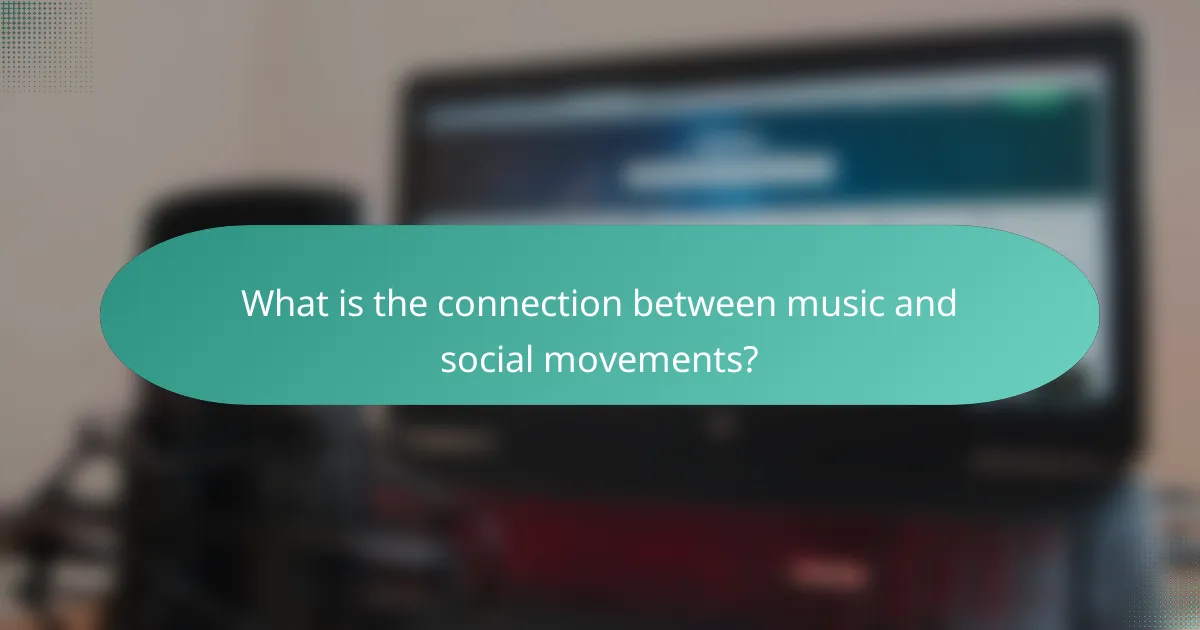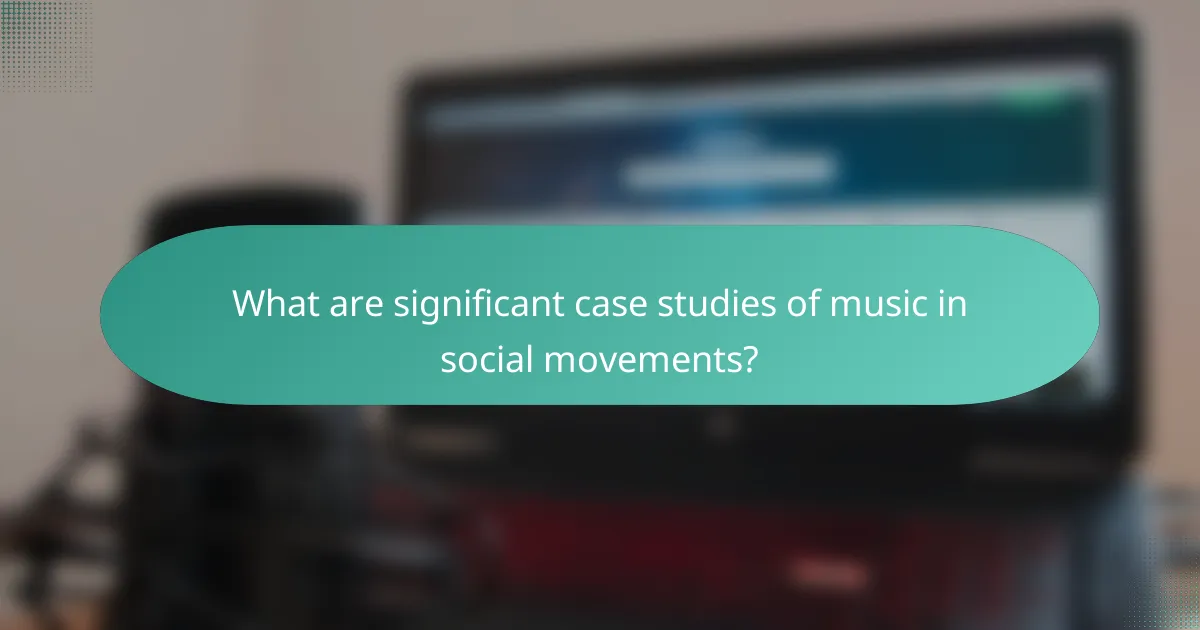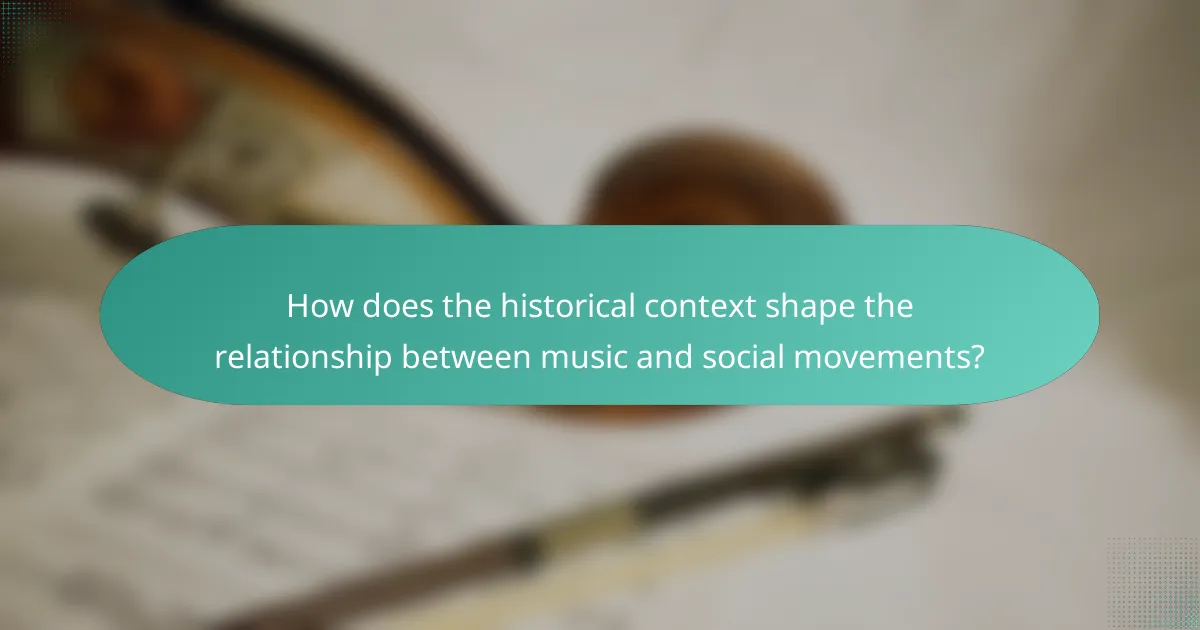The article examines the connection between music and social movements, highlighting how music serves as a tool for conveying messages and uniting individuals in the fight for social justice. It discusses significant case studies, including the Civil Rights Movement, anti-Vietnam War protests, and the South African anti-apartheid struggle, illustrating how songs like “We Shall Overcome” and “Nkosi Sikelel’ iAfrika” became anthems of resistance and hope. The historical context is crucial in shaping the relationship between music and activism, as music often reflects the social, political, and economic conditions of its time, inspiring action and fostering community among activists. Through this exploration, the article emphasizes the enduring power of music to mobilize support and influence public opinion on critical social issues.

What is the connection between music and social movements?
Music serves as a powerful tool for social movements by conveying messages and uniting individuals. It often reflects the struggles and aspirations of marginalized groups. Historically, songs have galvanized support for civil rights, anti-war protests, and other social causes. For example, “We Shall Overcome” became an anthem for the Civil Rights Movement in the 1960s. Music can inspire action and foster a sense of community among activists. Additionally, it raises awareness about social issues through lyrics and performances. The connection between music and social movements is evident in its ability to mobilize people and influence public opinion.
How has music historically influenced social movements?
Music has historically influenced social movements by serving as a powerful tool for expression and mobilization. Throughout history, songs have encapsulated the struggles and aspirations of marginalized groups. For instance, during the Civil Rights Movement, artists like Bob Dylan and Sam Cooke created anthems that inspired activism. “A Change is Gonna Come” by Cooke became synonymous with the fight for racial equality.
In the 1960s, protest songs became a rallying cry for anti-war sentiments during the Vietnam War. Artists like Joan Baez and Peter, Paul and Mary used their music to unify protestors and spread messages of peace. The anti-apartheid movement in South Africa also utilized music, with songs like “Nkosi Sikelel’ iAfrika” galvanizing support for the struggle against racial oppression.
Moreover, music festivals and concerts have historically provided platforms for social messages. The Woodstock Festival in 1969 became a symbol of counterculture and peace. In summary, music has been integral to social movements, influencing public opinion and encouraging collective action.
What are some key examples of music as a catalyst for change?
Music has historically served as a catalyst for social change. One key example is “We Shall Overcome,” which became an anthem of the Civil Rights Movement in the 1960s. This song united activists and inspired collective action against racial injustice. Another significant instance is “Imagine” by John Lennon, promoting peace and global harmony during the Vietnam War era. It encouraged listeners to envision a world without conflict.
Furthermore, “Fight the Power” by Public Enemy highlighted racial inequality and became a rallying cry for the Black Lives Matter movement. It underscored the struggles against systemic oppression. Additionally, Bob Dylan’s “The Times They Are a-Changin'” resonated with the counterculture of the 1960s, advocating for social reforms and generational change. These examples illustrate how music has effectively mobilized communities and influenced societal transformations throughout history.
How do different genres of music contribute to social movements?
Different genres of music contribute to social movements by providing a platform for expression and solidarity. Genres like folk music have historically been used in protests, as seen in the Civil Rights Movement. Artists like Bob Dylan and Joan Baez used their songs to inspire activism and unite individuals. Hip-hop has also played a crucial role, with artists like Public Enemy addressing social injustices and mobilizing youth. Punk rock emerged as a voice against political oppression, promoting anti-establishment sentiments. Reggae music, particularly through artists like Bob Marley, has highlighted issues of inequality and resistance. The emotional resonance of these genres fosters community engagement and raises awareness of social issues. Music festivals often serve as rallying points for movements, amplifying messages across diverse audiences.
Why is music considered a powerful tool in activism?
Music is considered a powerful tool in activism because it can inspire, unify, and mobilize people. It evokes emotions and creates a sense of shared identity among listeners. Historical examples illustrate music’s impact, such as the Civil Rights Movement, where songs like “We Shall Overcome” became anthems for change. Research shows that music can enhance group cohesion and increase participation in social movements. Studies indicate that music can effectively communicate messages and values, making complex issues more accessible. The ability of music to transcend language barriers further amplifies its role in global activism.
What psychological effects does music have on social mobilization?
Music can significantly influence social mobilization by fostering group identity and emotional connection. It creates a shared experience among individuals, enhancing feelings of solidarity. This emotional resonance can motivate collective action. Research indicates that music can activate areas in the brain associated with reward and emotion. For example, songs used during protests can evoke strong feelings of empowerment and urgency. Historical movements, like the Civil Rights Movement, effectively utilized music to unify and inspire participants. The song “We Shall Overcome” became an anthem that galvanized activists. Thus, music serves as a powerful psychological tool in mobilizing social movements.
How does music foster community and solidarity among activists?
Music fosters community and solidarity among activists by creating shared emotional experiences. It serves as a unifying force during protests and gatherings. Songs with powerful lyrics can inspire collective action and motivate individuals. Historical examples include the civil rights movement, where songs like “We Shall Overcome” became anthems of hope. Research indicates that music enhances group cohesion by promoting a sense of belonging. Additionally, communal singing fosters social bonds and reinforces shared goals. Music also helps to communicate messages effectively, making complex ideas accessible. Ultimately, these elements combine to strengthen the activist community.

What are significant case studies of music in social movements?
Significant case studies of music in social movements include the Civil Rights Movement, anti-Vietnam War protests, and the South African anti-apartheid movement. During the Civil Rights Movement, songs like “We Shall Overcome” unified activists and inspired hope. Artists such as Bob Dylan and Joan Baez used their music to raise awareness and support for civil rights. The anti-Vietnam War protests featured songs like “Fortunate Son” by Creedence Clearwater Revival, which criticized the war and its impact on the working class. In South Africa, the song “Nkosi Sikelel’ iAfrika” became an anthem for the anti-apartheid struggle, symbolizing resistance and unity. These case studies demonstrate the powerful role music plays in mobilizing communities and expressing social and political messages.
How did the civil rights movement utilize music?
The civil rights movement utilized music as a tool for protest and unity. Songs served to inspire activists and communicate messages of hope. They often conveyed the struggles faced by African Americans. Popular songs included “We Shall Overcome” and “Ain’t Gonna Let Nobody Turn Me Around.” These anthems were sung at rallies and marches, fostering a sense of community. Music also helped to raise awareness of civil rights issues. Artists like Nina Simone and Sam Cooke addressed social injustices through their lyrics. The incorporation of music into the movement galvanized support and spread its message across the nation.
What songs became anthems for the civil rights movement?
Songs that became anthems for the civil rights movement include “We Shall Overcome,” “A Change Is Gonna Come,” and “Fight the Power.” “We Shall Overcome” originated in the early 20th century and became a rallying cry during protests. “A Change Is Gonna Come” was written by Sam Cooke in 1964, reflecting the struggles faced by African Americans. “Fight the Power” by Public Enemy was released in 1989 and addressed systemic racism and inequality. These songs played significant roles in unifying activists and conveying messages of hope and resistance.
How did artists contribute to the movement’s message through music?
Artists contributed to the movement’s message through music by using their platforms to raise awareness and inspire change. They wrote songs that reflected the struggles and aspirations of the movement. For instance, protest songs became anthems, uniting people under common causes. Artists like Bob Dylan and Joan Baez were pivotal during the civil rights movement. Their music conveyed powerful messages about equality and justice. Songs such as “Blowin’ in the Wind” posed important questions about peace and freedom. Music festivals also served as gathering spaces for activists, amplifying the movement’s reach. Additionally, artists often collaborated with grassroots organizations, integrating their music into rallies and demonstrations. This synergy between music and activism helped solidify the movement’s message in the public consciousness.
What role did music play in the anti-war movements?
Music served as a powerful tool for expression and mobilization during the anti-war movements. It united individuals under a shared message of dissent. Songs like “Give Peace a Chance” by John Lennon became anthems for peace. These songs often conveyed strong anti-war sentiments and highlighted the futility of conflict. Music festivals, such as Woodstock in 1969, further amplified these messages. They provided platforms for artists to voice opposition to war. The emotional resonance of music helped to galvanize public opinion against military actions. Overall, music played a crucial role in shaping the cultural landscape of the anti-war movements.
Which artists were pivotal in shaping the anti-war narrative?
Bob Dylan, Joan Baez, and Pete Seeger were pivotal in shaping the anti-war narrative. Bob Dylan’s song “Blowin’ in the Wind” became an anthem for the civil rights and anti-war movements. Joan Baez used her music to protest against the Vietnam War and advocate for peace. Pete Seeger was known for his folk songs that highlighted social justice issues, including anti-war sentiments. These artists utilized their platforms to raise awareness and inspire activism. Their contributions significantly influenced public opinion against war during the 1960s and beyond.
What impact did protest songs have on public opinion during the Vietnam War?
Protest songs significantly influenced public opinion during the Vietnam War. These songs voiced dissent against the war and resonated with anti-war sentiments. Artists like Bob Dylan and Joan Baez became prominent figures in the movement. Their music articulated the frustrations and fears of many Americans. Songs such as “Blowin’ in the Wind” and “Fortunate Son” became anthems for the anti-war movement. The widespread airplay of these songs helped to mobilize public protests. Surveys indicated a shift in public opinion, with growing opposition to the war correlating with the popularity of protest music. This cultural phenomenon highlighted the power of music as a tool for social change.

How does the historical context shape the relationship between music and social movements?
Historical context significantly shapes the relationship between music and social movements. Music often reflects the social, political, and economic conditions of its time. For example, during the Civil Rights Movement in the 1960s, songs like “We Shall Overcome” became anthems for change. These songs communicated messages of hope and resistance against oppression. Historical events, such as wars or civil unrest, influence the themes and styles of music. The anti-war movement in the 1970s produced protest songs that critiqued government policies. Additionally, music serves as a unifying force, bringing people together in shared experiences. The context of struggle or injustice often inspires artists to create works that resonate with their audiences. This dynamic relationship continues to evolve, as contemporary movements use music to raise awareness and mobilize support.
What historical events have led to the emergence of music-driven movements?
The emergence of music-driven movements has been influenced by several historical events. The civil rights movement in the 1960s utilized songs like “We Shall Overcome” to unify and inspire activists. The anti-war protests during the Vietnam War featured music from artists like Bob Dylan and Joan Baez, which voiced dissent against military actions. The women’s liberation movement adopted anthems such as “I Am Woman” to promote gender equality. The 1980s saw the rise of hip-hop, which addressed social issues and injustices faced by marginalized communities. The fall of the Berlin Wall in 1989 was marked by music that symbolized freedom and unity. Each of these events demonstrates how music has served as a powerful tool for social change and collective expression.
How do cultural shifts influence the themes in protest music?
Cultural shifts significantly influence the themes in protest music. As societal values evolve, musicians respond by addressing relevant issues. For instance, the civil rights movement in the 1960s inspired songs focused on racial equality. Artists like Bob Dylan and Nina Simone expressed the struggles of marginalized communities. Similarly, the anti-war movement prompted music that critiqued government policies. Songs from this era often highlighted the futility of conflict and the desire for peace. In recent years, themes of social justice and climate change have emerged. Artists like Billie Eilish and Childish Gambino reflect contemporary concerns through their lyrics. Thus, protest music serves as a mirror to cultural shifts, adapting to the pressing issues of each era.
What lessons can be learned from past music-related social movements?
Music-related social movements demonstrate the power of unity and collective action. They show how music can amplify messages of social justice. Historical examples include the civil rights movement, where songs like “We Shall Overcome” inspired activism. Additionally, the anti-war movement used music to protest against conflict, as seen with songs like “Give Peace a Chance.” These movements teach that music can foster community and solidarity. They highlight the importance of cultural expression in driving social change. Moreover, they reveal that music can mobilize individuals and raise awareness on critical issues. Finally, the effectiveness of music in social movements underscores its role as a tool for emotional connection and motivation.
How can contemporary movements apply these lessons today?
Contemporary movements can apply lessons from historical social movements by utilizing music as a tool for unity and awareness. Music has historically galvanized communities and spread messages effectively. For instance, the civil rights movement used songs like “We Shall Overcome” to inspire collective action. Today, movements can adopt similar strategies by creating anthems that resonate with their causes.
Additionally, leveraging social media platforms can amplify these musical messages. Historical movements often relied on live performances and gatherings. In contrast, contemporary movements can reach wider audiences through digital channels. This approach allows for the rapid dissemination of songs that promote their agendas.
Moreover, music can serve as a form of protest and a means to express dissent. The anti-apartheid movement in South Africa showcased how music can challenge oppressive systems. By composing and sharing protest songs, contemporary movements can articulate their struggles and aspirations.
Lastly, collaborations between artists and activists can enhance the impact of these musical initiatives. Historical examples, such as Bob Dylan’s influence on the anti-war movement, demonstrate the power of artist involvement. Today, partnerships between musicians and social causes can foster greater engagement and inspire action.
What are best practices for using music in modern social activism?
Best practices for using music in modern social activism include creating relatable content, collaborating with activists, and leveraging social media. Relatable content resonates with audiences and enhances emotional connection. Collaborating with activists ensures that the music aligns with the cause and message. Leveraging social media amplifies reach and engagement, allowing for wider dissemination of the message. Historical examples include the civil rights movement, where songs like “We Shall Overcome” united and mobilized people. Research shows that music can increase awareness and motivate action, making it a powerful tool in activism.
The main entity of the article is the connection between music and social movements. The article explores how music serves as a powerful tool for expression, mobilization, and unity within various social movements throughout history. Key examples include the Civil Rights Movement, anti-war protests, and the anti-apartheid movement, highlighting significant songs and artists that have influenced public opinion and galvanized collective action. Additionally, it discusses the psychological effects of music on social mobilization and best practices for using music in contemporary activism, emphasizing the importance of cultural context and collaboration with activists.